General, Sir John Monash, Personal Files Book 20, 15 August - 8 September 1918 - Part 15
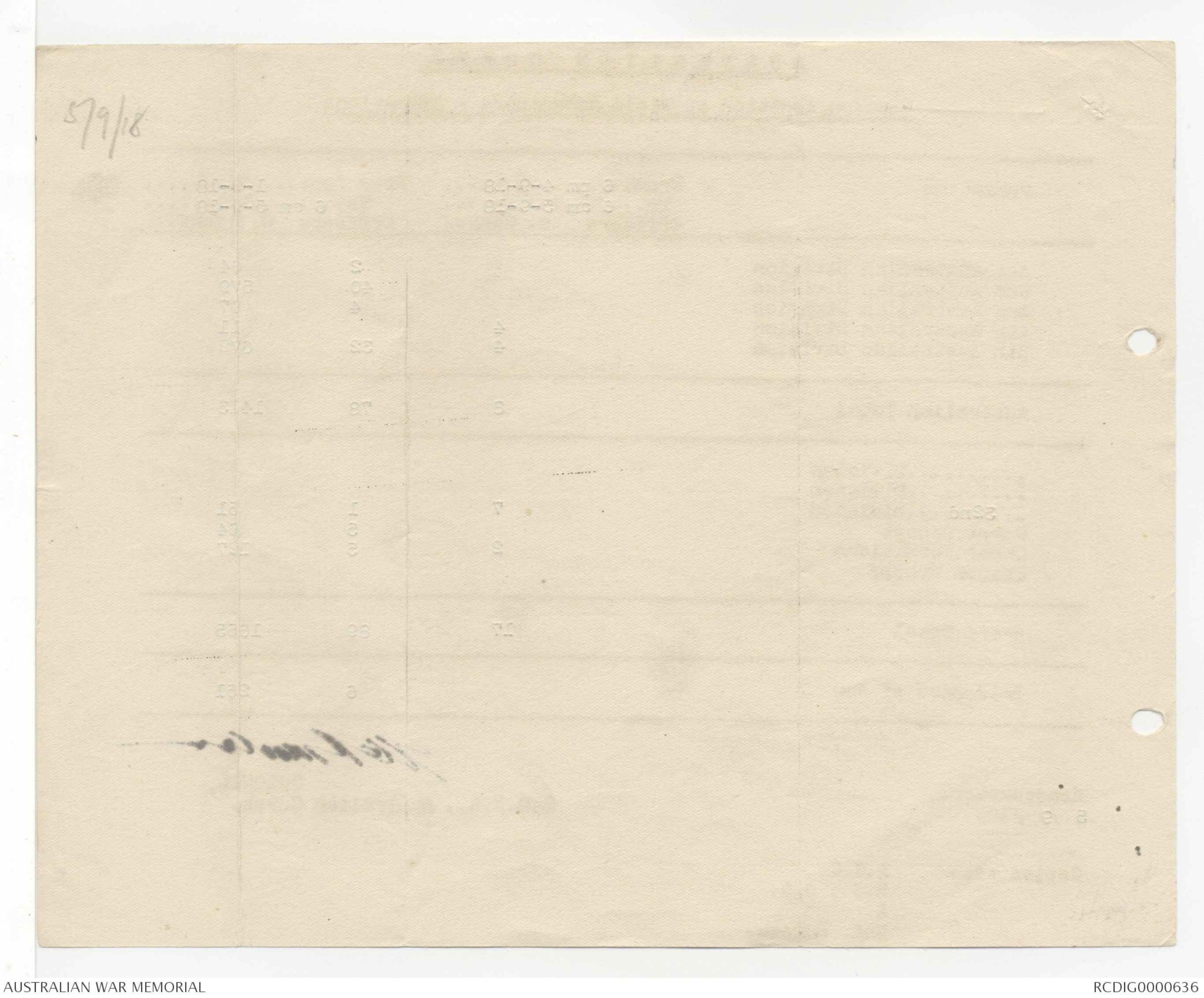
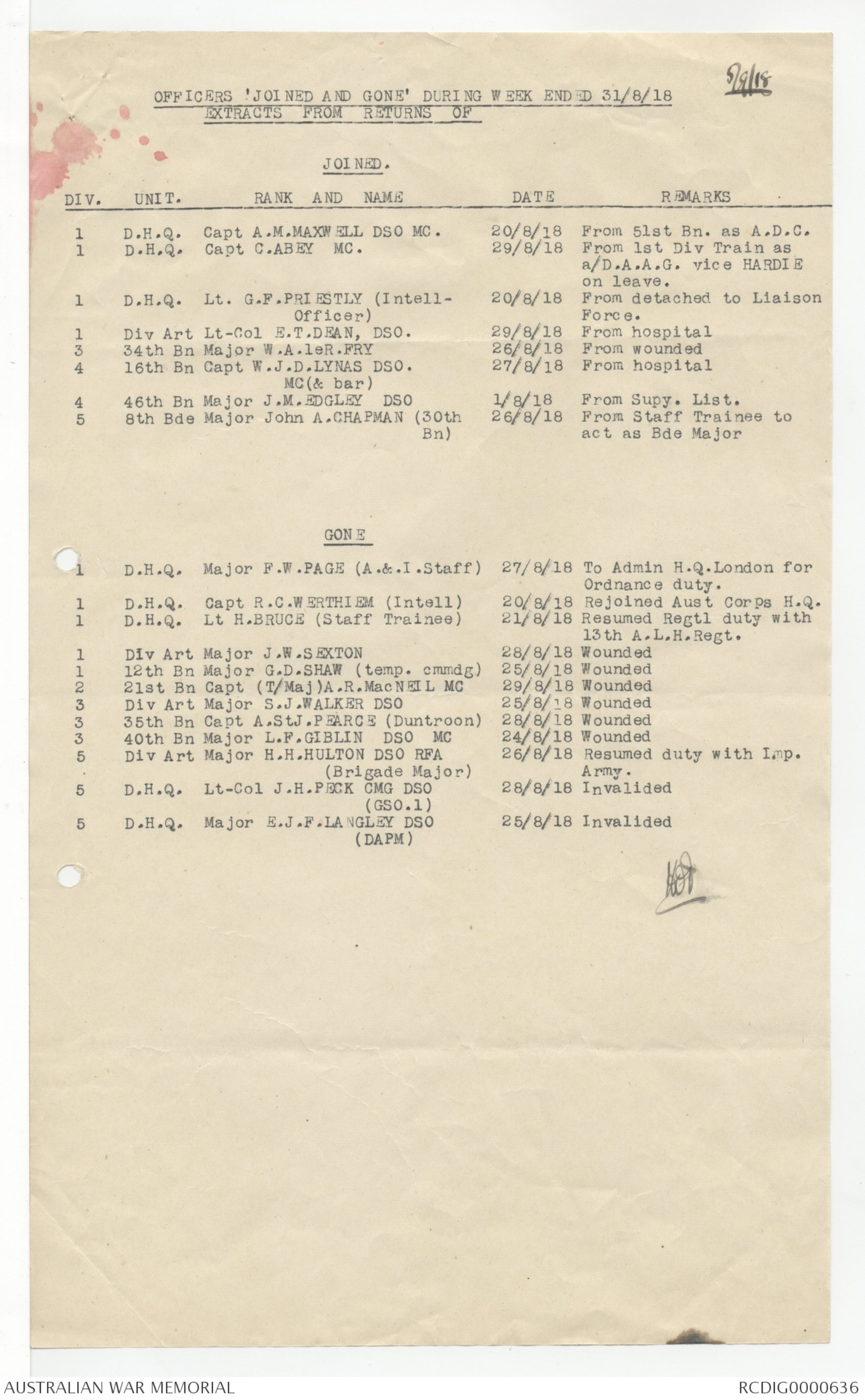
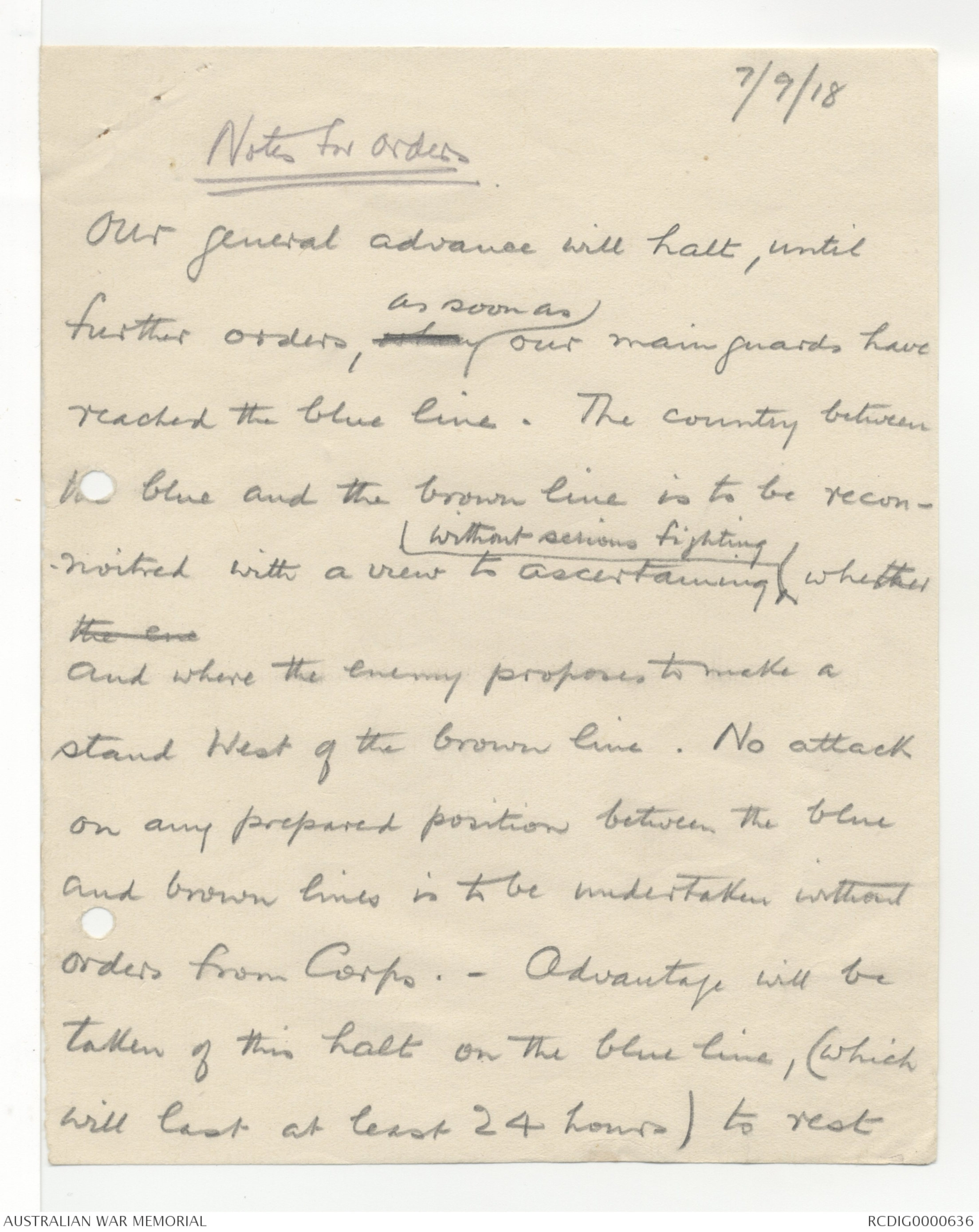
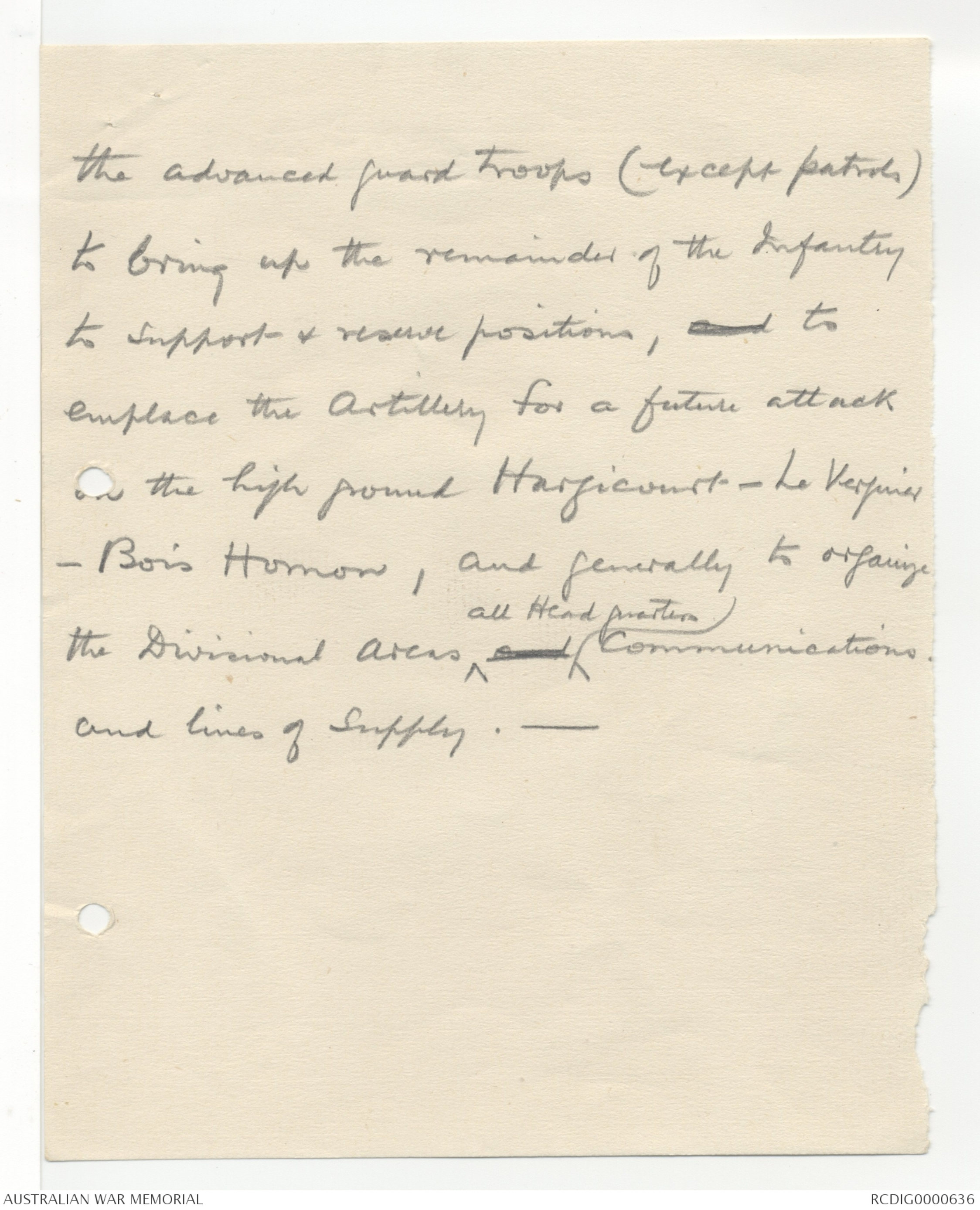
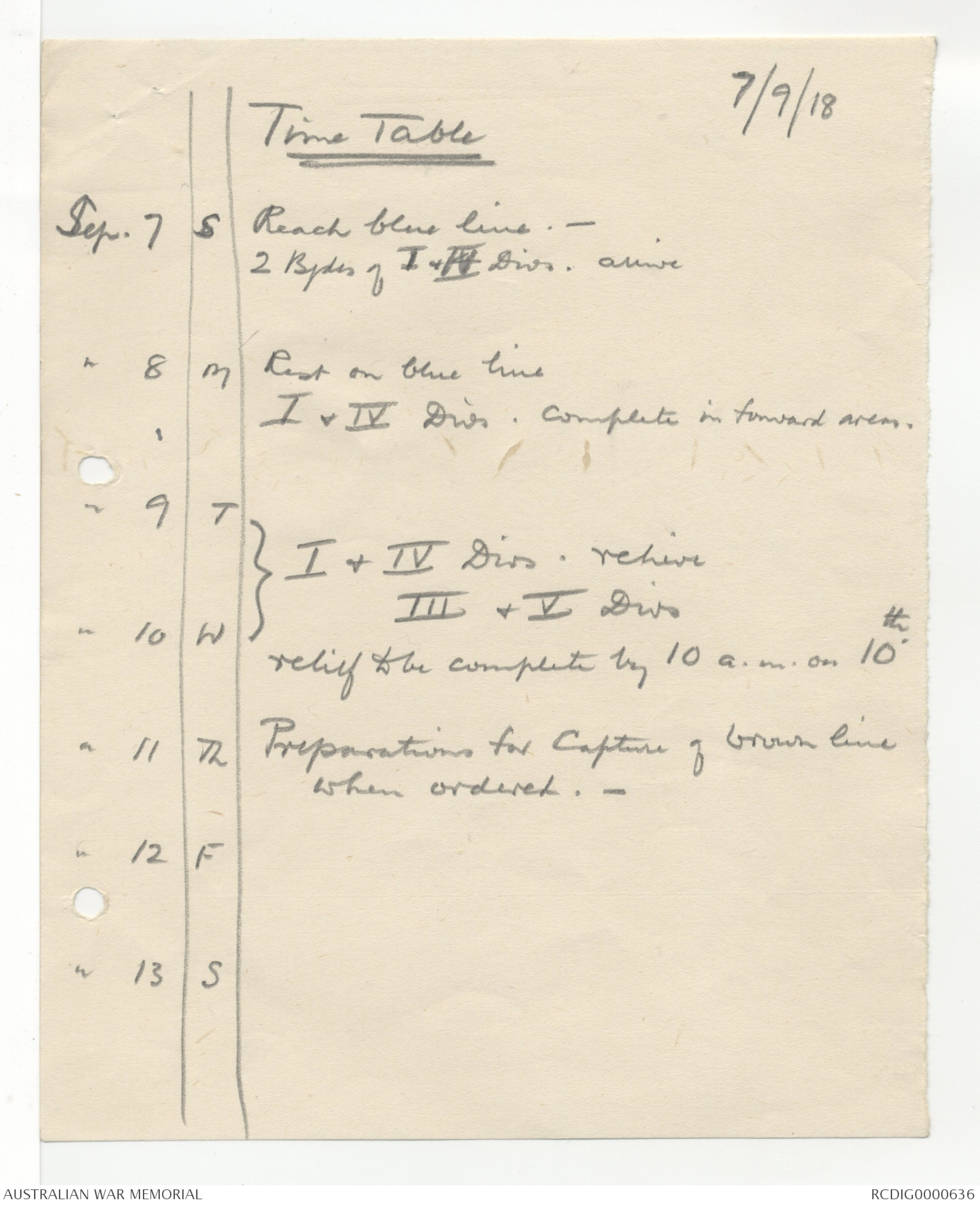
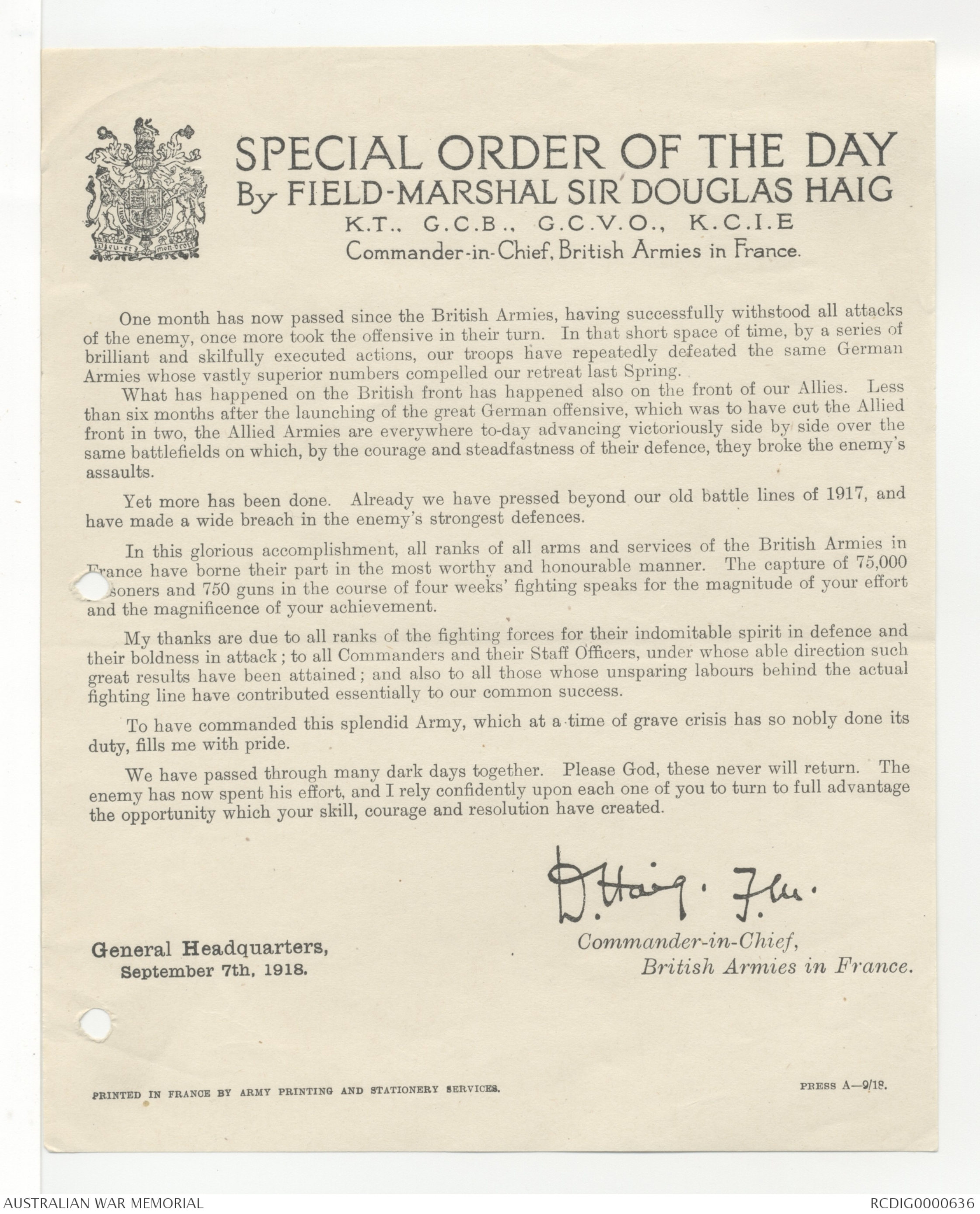
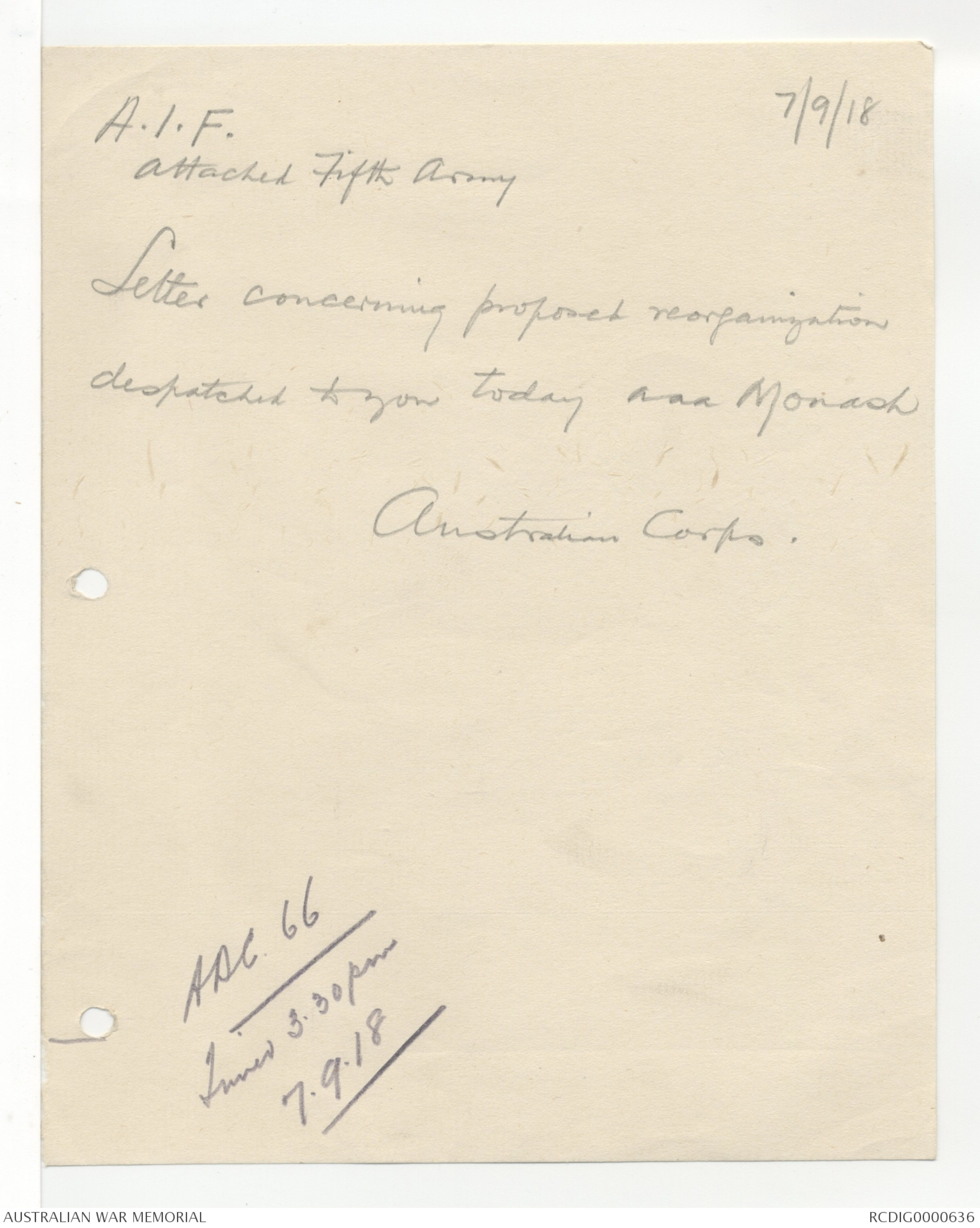
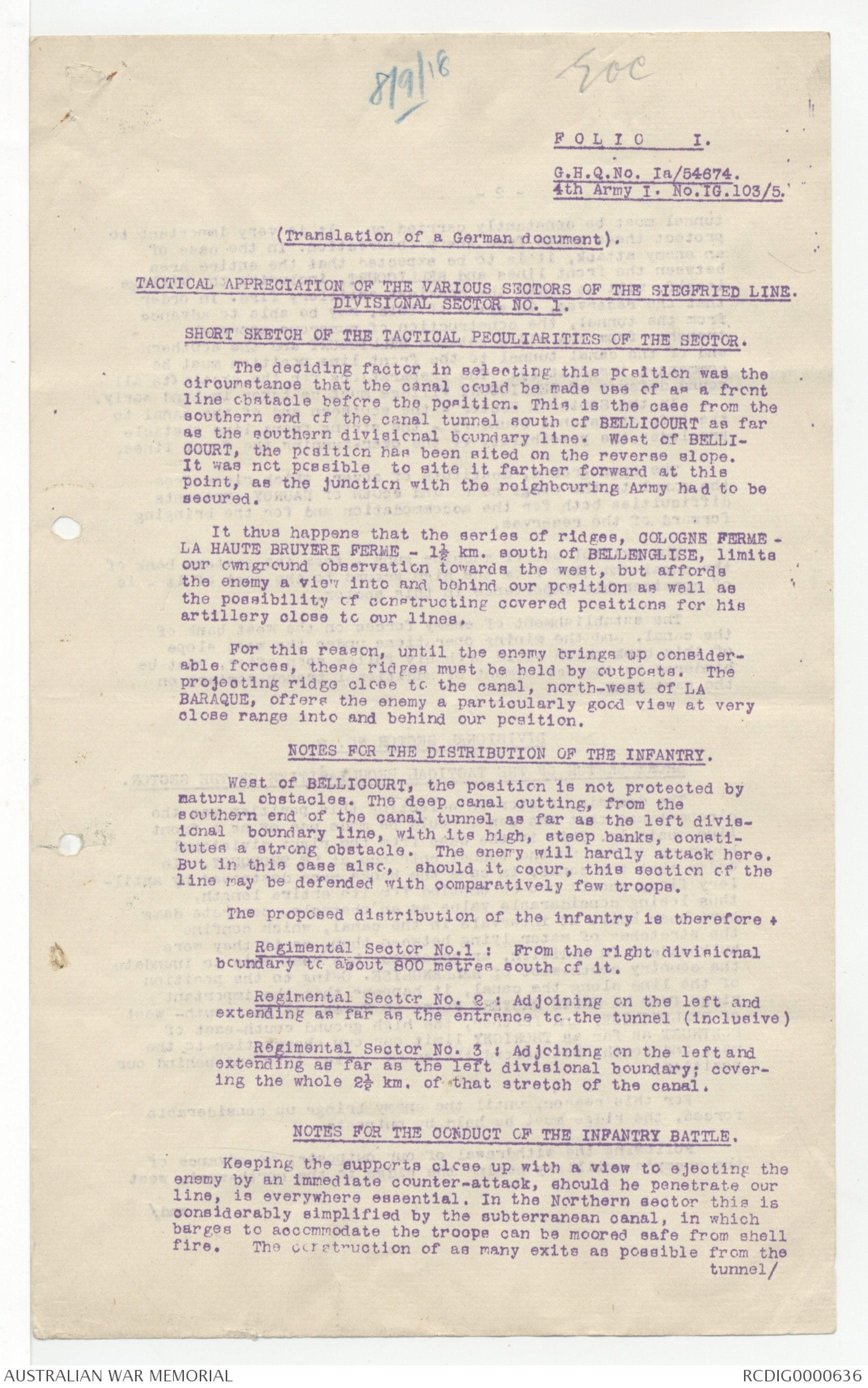
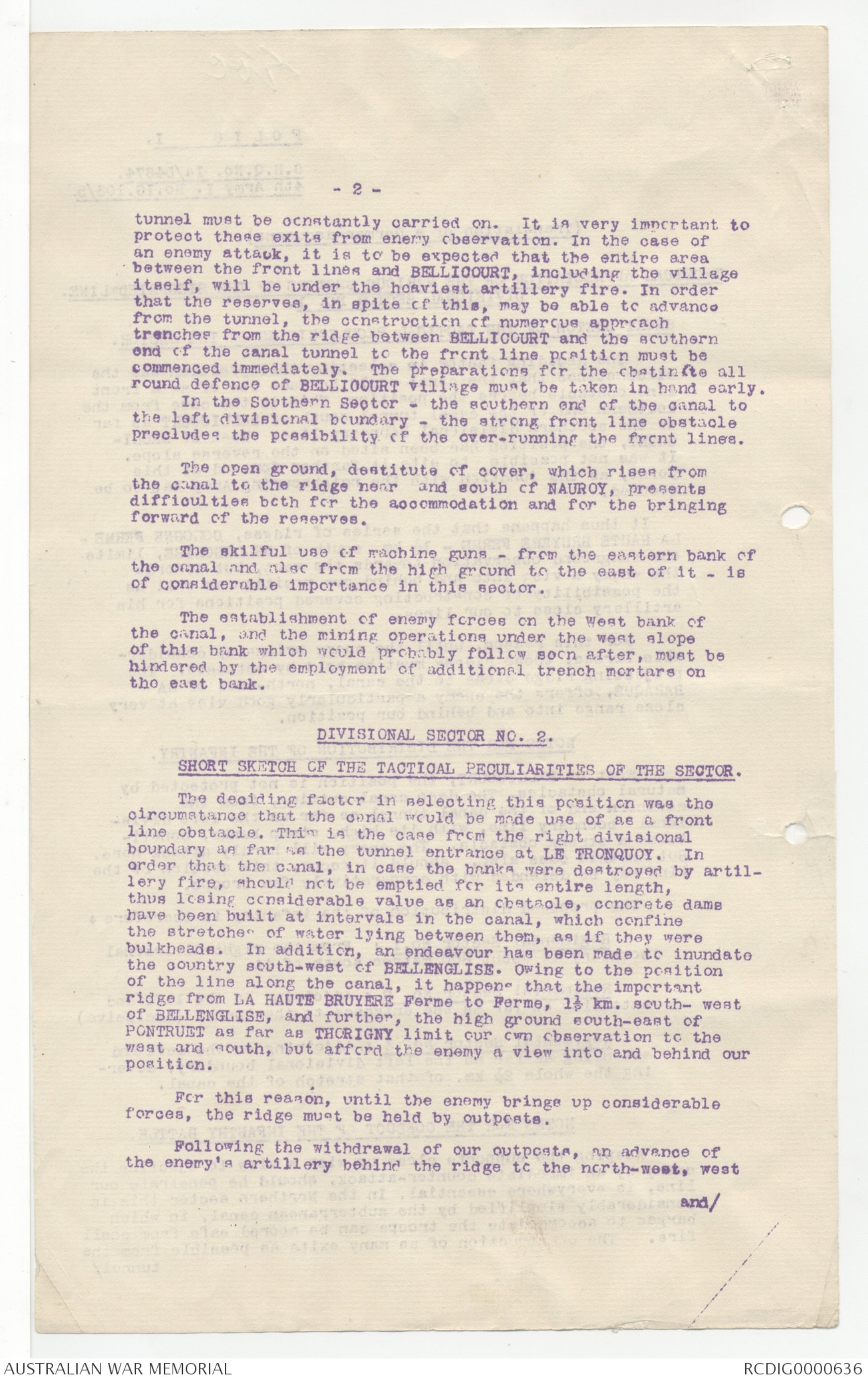
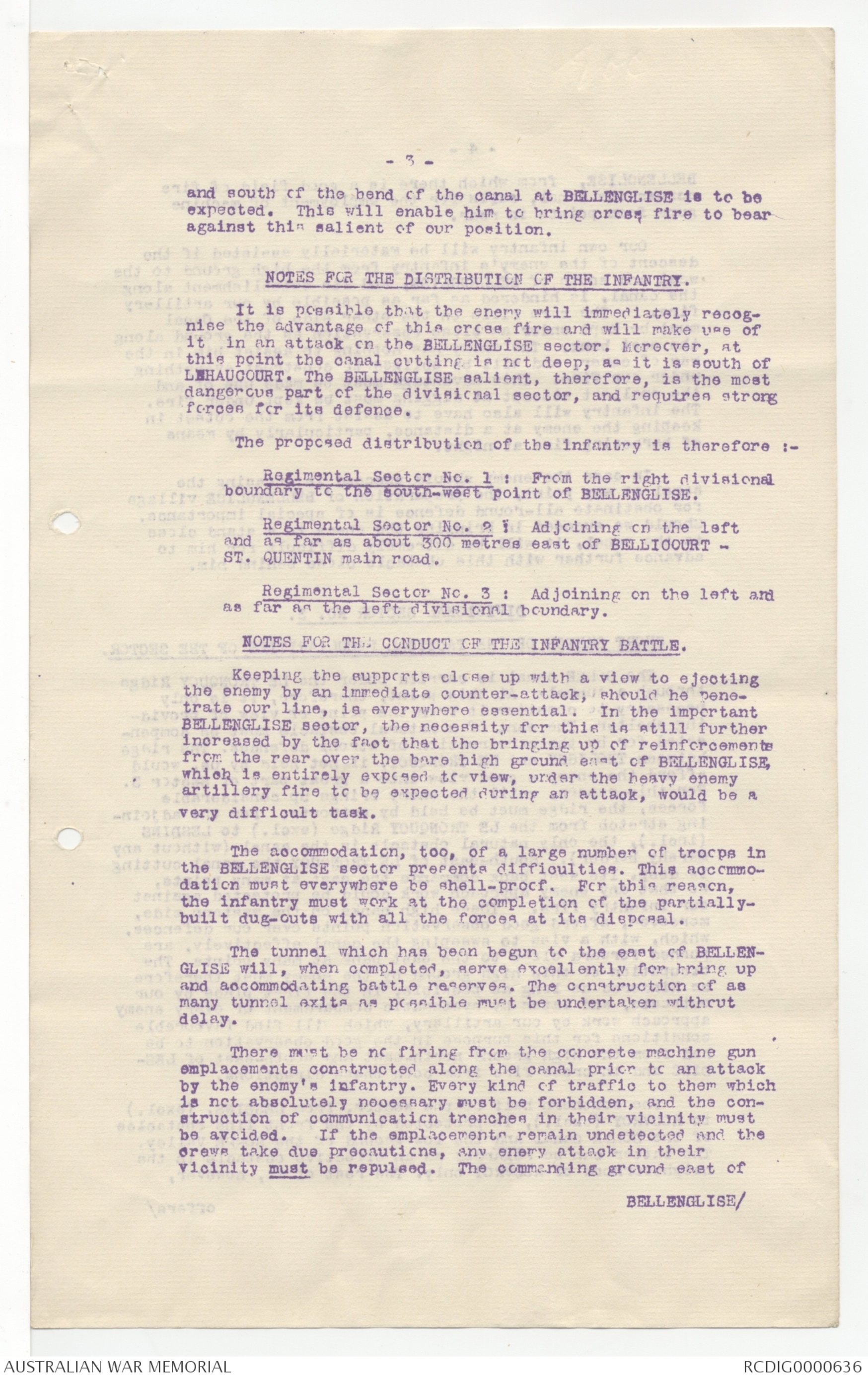
5/9/18
|
5/9/18 OFFICERS ‘JOINED AND GONE’ DURING WEEK ENDED 31/8/18 EXTRACTS FROM RETURNS OF |
||||
|
JOINED. |
||||
| DIV. | UNIT | RANK AND NAME | DATE | REMARKS |
| 1 | D.H.Q. | Capt A.M.Maxwell DSO. MC. | 20/8/18 | From 51st Bn. as A.D.C. |
| 1 | D.H.Q. | Capt C.Abey MC. | 29/8/18 | From 1st Div. Train as a/D.A.A.G. vice HARDIE on leave. |
| 1 | D.H.Q. | Lt. G.F. PRIESTLY (Intell-Officer) | 28/8/18 | From detached to Liaison Force. |
| 1 | Div. Art | Lt-Col E.T.DEAN, DSO. | 29/8/18 | From hospital |
| 3 | 34thBn | Major W.A.LeR.FRY | 26/8/18 | From wounded |
| 4 | 46thBn | Major J.M.EDGLEY DSO | 1/8/18 | From Supy. List |
| 5 | 8thBde | Major John A.CHAPMAN (30th BN) | 26/8/18 | From Staff Trainee to act as Bde Major |
|
GONE |
||||
| 1 | D.H.Q. | Major F.W. PAGE (A.&I.Staff) | 27/8/18 |
To Admin H.Q.London for Ordnance duty |
| 1 | D.H.Q. | Capt R.C.WERTHIEM (Intell) | 20/08/18 | Rejoined Aust Corps H.Q. |
| 1 | D.H.Q. | LT H.BRUCE (Staff Trainee) | 21/8/18 | Resumed Regtl duty with 13th A.L.H.Regt. |
| 1 | Div Art | Major J.W.SEXTON | 28/8/18 | Wounded |
| 1 | 12th Bn | Major G.D.SHAW (temp. cmmdg) | 25/8/18 | Wounded |
| 2 | 21stBn | Capt (T/Maj) A.R.MacNEIL MC | 29/8/18 | Wounded |
| 3 | Div Art | Major S.J.WALKER DSO | 25/8/18 | Wounded |
| 3 | 35th Bn | Capt A.S.tJ.PEARCE (Duntroon) | 28/8/18 | Wounded |
| 3 | 40th Bn | Major L.F.GIBLIN DSO MC | 24/8/18 | Wounded |
| 5 | Div Art |
Major H.H.HULTON DSO RFA (Brigade Major) |
26/8/18 |
Resumed duty with Imp. Army. |
| 5 | D.H.Q. | Lt-Col J.H.PECK CMG DSO (GSO.1) | 28/8/18 | Invalided |
| 5 | D.H.Q. | Major E.J.F.LANGLEY DSO (DAPM) | 25/8/18 | Invalided |
Signature
7/9/18
Notes for Orders
Our general advance will halt, until
further orders, when ^ as soon as our main guards have
reached the blue line. The country between
the blue and the brown line is to be recon-
noitred with a view to ascertaining ^ without serious fighting whether
the enc
and where the enemy proposes to make a
stand west of the brown line. No attack
on any prepared position between the blue
and brown lines is to be undertaken without
orders form Corps.- Advantage will be
taken of this halt on the blue line, (which
will last at least 24 hours) to rest
the advanced guard troops (except patrols)
to brin gup the remainder of the Infantry
to support & reserve positions, to
emplace the artillery for a future attack
on the high ground Hargicourt - Le Verfiner
- Bois Hamon, and generally to organise
the Divisional areas ^ all Headquarters communications,
and lines of supply.-
| Time Table | ||
| Sept 7 | S |
Reach blue line. – 2 Bgdes of I & IV Divs. arrive |
| " 8 | M |
Rest on blue line I & IV Divs. complete in forward areas. |
| " 9 | T |
) I & IV Divs. relieve ) III & V Divs relief to be complete by 10a.m. on 10th |
| " 10 | W | |
| " 11 | Th |
Preparations for capture of brown line when ordered. - |
| " 12 | F | |
| " 13 | S |
SPECIAL ORDER OF THE DAY
By FIELD-MARSHAL SIR DOUGLAS HAIG
K.T., G.C.B., G.C.V.O., K.C.I.E
Commander-in-Chief, British Armies in France.
One month has now passed since the British Armies, having successfully withstood all attacks
of the enemy, once more took the offensive in their turns. In that short space of time, by a series of
Armies whose vastly superior numbers compelled our retreat last Spring.
What has happened on the British front has happened also on the front of our Allies. Less
than six months after the launching of the great Germ offensive, which was to have cut the Allied
front in two, the Allied Armies are everywhere to-day advancing victoriously side by side over the
same battlefields on which, by the courage and steadfastness of their defence, they broke the enemy's
assaults.
Yetmore has bene dones. Already we have pressed byond our old battle lines of 1917, and
have made a wide breach in the enemy's strongest defences.
In this glorious accomplishment, all ranks of all arms and services of the British Armies in
France have borne their part in the most worthy and honourable manner. The capture of 75,000
prisoners and 750 guns in the course of four weeks' fighting speaks for the magnitude of your effort
and the magnificence of your achievement.
Many thanks are due to all ranks of the fighting forces for their indomitable spirit in defence and
their boldness in attack; to all Commanders and their Staff Officers, under whose able direction such
great results have been attained; and also to all those whose unsparing labours behind the actual
fighting line have contributed essentially to our common success.
To have commanded this splendid Army, which at a time of grave crisis has so nobly done its
duty, fills me with pride.
We have passed through many dark days together. Please God, these will never return. The
enemy has now spent his effort, and I rely confidently upon each of you to turn to full advantage
the opportunity which your skill, courage and resolution have created.
D. Haig. Flu.
General Headquarters Commander-In-Chief,
September 7th, 1918 British Armies in France.
PRINTED IN FRANCE BY ARMY PRINTING AND STATIONERY SERVICES
PRESS A-9/18.
7/9/18
A.I.F.
Attached Fifth Army
Letter concerning proposed reorganisation
dispatched to you today aaa Monash
Australian Corps.
ADC. 66
Timed 3.30pm
7/9/18
8/9/18 GOC
F O L I O I
G.H.Q.No. 1a/54674.
4th Amy 1. No.IG.103/5.
(Translation of a German document).
TACTICAL APPRECIATION OF THE VARIOUS SECTORS OF THE SIEGRIED LINE.
DIVISIONAL SECTOR NO. 1.
SHORT SKETCH OF THE TACTICAL PECULARITIES OF THE SECTOR.
The deciding factor in selecting this position was the
circumstances that the canal could be made use of as a front
line obstacle before the position. This is the case from the
southern end of the canal tunnel south of BELLICOURT as far
as the southern divisional boundary line. West of BELLI-
COURT, the position has been sited on the reverse slope.
It was not possible to site it farther forward at this
point, as the junction with the neighbouring Army had to be
secured.
It thus happens that the series of ridges, COLOGNE FERME-
LA HAUTE BRUYERE FERME - 1 1/2 km. south of BELLINGLISE, limits
our ownground observation towards the west, but affords
the enemy a view into and behind our position as well as
the possibility of constructing covered positions for his
artillery close to our lines.
For this reason, until the enemy brings up consider-
able forces, these ridges must be held by outposts. The
projecting ridge close to the canal, north-west of LA
BARAQUE, offers the enemy a particularly good view at very
close range into and behind our position.
NOTES FOR THE DISTRIBUTION OF THE INFANTRY.
West of BELLCOURT, the position is not protected by
natural obstacles. The deep canal cutting, from the
southern end of the canal tunnel as far as the left divis-
ional boundary line, with its high, steep banks, consti-
tues a strong obstacle. The enemy will hardly attack here.
But in this case also, should it occur, this section of the
line may be defended with comparatively few troops.
The proposed distribution of the infantry is therefore +
Regimental Sector No. 1 : From the right divisional
boundary to about 800 metres south of it.
Regimental Sector No. 2 : Adjoining on the left and
extending as far as the entrance to the tunnel (inclusive)
Regimental Sector No. 3 : Adjoining on the left and
extending as far as the left divsional boundary; cover-
ing the whole 2 1/2 Km. of that stretch of the canal.
NOTES FOR THECONDUCT OF THE INFANTRY BATTLE.
Keeping the supports close up with a view to ejectin gthe
enemy by an immediate counter-attack, should he penetrate our
line, is everywhere essential. In the Northern sector this is considerably simmplified by the subterranean canal, in which
barges to accommodate the troops can be moored safe from shell
fire. The construction of as many exits as possible from the tunnel/
-2-
tunnel must be constantly carried on. It is very important to
protect these exits from enemy observation. In the case of
an enemy attack, it is to be expected that the entire area
between the front lines and BELLICOURT, including the village
itself, will be under the heaviest artillery fire. In order
that the reserves, in spite of this, may be able to advance
from the tunnel, the construction of numerous approach
trenches from the ridge between BELLICOURT and the southern
end of the canal tunnel to the front line position must be
commenced immediately. The preparations for the obstinate all round defence of BELLICOURT village must be taken in hand early.
In the Southern Sector - the strong front line obstacle
precludes the possibility of the over-running the front lines.
The open ground, destitute of cover, which rises from
the canal to the ridge near and south of NAUROY, presents
difficulties both for the accommodation and for the bringing
forward of the reserves.
The skilful use of machine guns - from the eastern bank of
the canal and also from the high ground to the east of it - is
of considerable importance in this sector.
The establishment of enemy forces on the West bank of
the canal, and themining operations under the west slope
of this bank whihc would probably follow soon after, must be
hindered by the employment of additional trench mortars on
the east bank.
DIVISIONAL SECTOR NO. 2
SHORT SKETCH OF THE TACTICAL PECULIARITIES OF THE SECTOR.
The deciding factor in selecting this position was the
circumstance that the canal would be made use of as a front
line obstacle. This is the case from the right divisional
boundary as far as the tunnel entrace at LE TRONQUOY. In o
order that the canal, in case the banks were destroyed by artil-
lery fire, should not be emptied for its entire length,
thus losing considerable value as an obstacle, concreate dams
have been built at intervals in the canal, which confine the stretches of water lying between them, as if they were
bulk heads. In addition, an endeavour has been made to inundate
the country south-west of BELLENGLISE. Owing to the position
of the line along the canal, it happens that the important
ridge from LA HAUTE BRUYERE Ferme to Ferme, 11/2 km. south- west
of BELLENGLISE, and further, the high ground south-east of
PONTRUET as far as THORIGNY limit our own observation to the
west and south, but afford the enemy a view into and behind our
position.
For this reason, until the the enemy brings up considerable
forces, the ridge must be held by outposts.
Following the withdrawal of our outposts, anadvance of
the enemy's artillery behind the ridge to the north-west, west
and/
NOTES FOR THE DISTRIBUTION OF THE INFANTRY.
It is possible that the enemy will immediately recog-
nise the advantage of this cross fire and will make use of
it in an attack on the BELLENGLISE sector. Moreover, at
this point the canal cutting is not deep, as it is south of
LEHAUCOURT. The BELLENGLISE salient, therefore, is the most
dangerous part of the divisional sector, and requires strong
forces for its defence.
The proposed distribution of the infantry is therefore :-
Regimental Sector No. 1 : From the right divisional
boundary to the south-west point of BELLENGLISE.
Regimental Sector No. 2 : Adjoining on the left
and as far as about 300 metres east of BELLICOURT -
ST. QUENTIN main road.
Regimental Sector No. 3 : Adjoining n the left and
as far as the left divisional boundary.
NOTES FOR THE CONDUCT OF THE INFANTRY BATTLE.
Keeping the supports close up with a view to ejecting
the enemy by an immediate counter-attack, should he pene-
trate our line, is everywhere essential. In the important
BELLENGLISE sector, the necessity for this is still further
increased by the fact that the bringing up of reinforcements
from the rear over the bare high ground east of BELLINENGLISE,
which is entire exposed to view, under the heavy enemy
artillery fire to be expected during an attack, would be a
very difficult task.
The accommodation, too, of a large number of troops in
the BELLENGLISE sector presents difficulties. This accommo-
dation must everywhere be shell-proof. For this reason,
the infantry must work at the completion of a partially-
built dug-outs with all the forces at its disposal.
The tunnel which has been begun to the east of BELLEN-
GLISE will, when completed, serve excellently for bring up
and accommodating battle reserves. The construction of as
many tunnel exits as possible must be undertaken without
delay.
There must be no firing from the concrete machine gun
emplacements constructed along the canal prior to an attack
by the enemy's infantry. Every kind of traffic to them which
is not absolutely necessary must be forbidden, and the con-
struction of communication trenches in their vicinity must
be avoided. If the emplacements remain undetected and the
crews take due precautions, any enemy attack in their
vicinity must be repulsed. The commanding ground east
BELLENGLISE/
 Sam scott
Sam scottThis transcription item is now locked to you for editing. To release the lock either Save your changes or Cancel.
This lock will be automatically released after 60 minutes of inactivity.